 February 22, 2015, First
February 22, 2015, First
Sunday of Lent
SOLEMNITY OF THE CHAIR OF ST. PETER

The feast commemorates Christ’s choice of Peter to sit in his place as the servant-authority of the whole Church. Already in the second half of the 8th century, an ancient wooden Chair
inlaid with ivory was venerated and traditionally held to be the Episcopal chair on which St. Peter sat as he instructed the faithful of Rome. In fact, it is a throne in which fragments
of acacia wood are visible, which could be part of the chair of St. Peter, encased in oak and reinforced with iron bands. Several rings facilitated its transportation during processions.
Pope Alexander VII commissioned Bernini to build a sumptuous monument which would give prominence to this ancient wooden chair. Bernini built a throne in gilded bronze, richly
ornamented with bas-reliefs in which the chair was enclosed: two pieces of furniture, one within the other. It was installed in 1666 on the altar just below the alabaster window
depicting the Holy Spirit. Every February 22, the altar of Peter's Chair is decorated with dozens of lighted candles, while the familiar black sculpture of St. Peter is dressed in full papal
regalia. Quite ironically, it was the last significant feast day of Benedict XVI's Pontificate, and it fell in Lent.
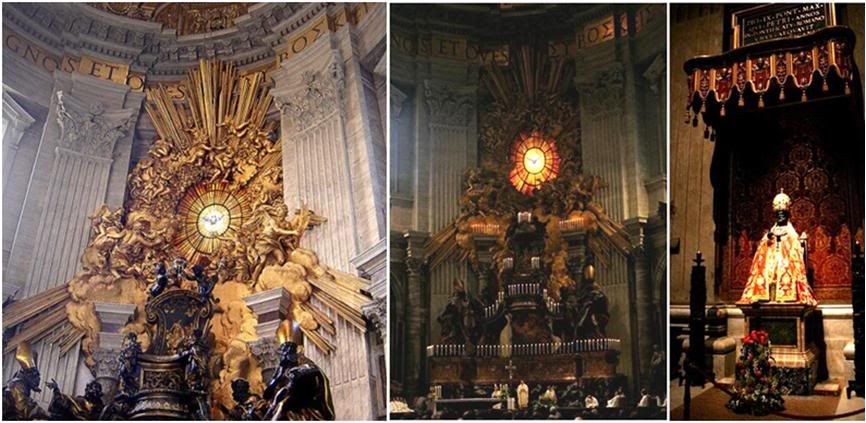 Left, Bernini's altar of Peter's Chair - the Church Doctors holding up the Chair are, on the left, Augustine and John Chrysostom, and on the right, Athanasius and Ambrose. Center, the altar with the lighted candles
Left, Bernini's altar of Peter's Chair - the Church Doctors holding up the Chair are, on the left, Augustine and John Chrysostom, and on the right, Athanasius and Ambrose. Center, the altar with the lighted candles
on Feb. 22; right, Arnolfo di Cambio's sculpture of St. Peter, dressed in papal regalia every Feb. 22.
AT THE VATICAN TODAY
Pope Francis led the midday Angelus at St. Peter's Square and soke about the significance of Lent, commenting on the temptaiton of Jesus by Satan. He made no mention about the Feast of Peter's Chair today.
[[I had to Google if somehow, the Feast of Peter's Chair is celebrated on another day this year because it coincides with the first Sunday of Lent. But all the information says it is celebrated February 22 this year. Father Z blogs about it, a traditionalist site features a homily that ties up the first Sunday of Lent with the Feast of Peter's Chair, so there must be another explanation for why the Pope did not say anything about it today...However, looking back at the reports from last year, when the Pope Francis's first cardinal-makign consistory fell on the Feast of Peter's Chair, the first for Francis as Pope, he made no reference at all to the pccasion in his allocution to his new cardinals. Why would the 266th Successor of Peter apparently ignore this solemnity?]
In the afternoon, the Pope and officials of the Roman Curia began their annual Lenten retreat at a retreat house in Ariccia, 16 miles from Rome. It will last till February 27.

Benedict XVI at the 2015 cardinal-naming consistory... Unlike this year, the emeritus Pope's appearance last year came as a complete surprise... The photos are truly moving.


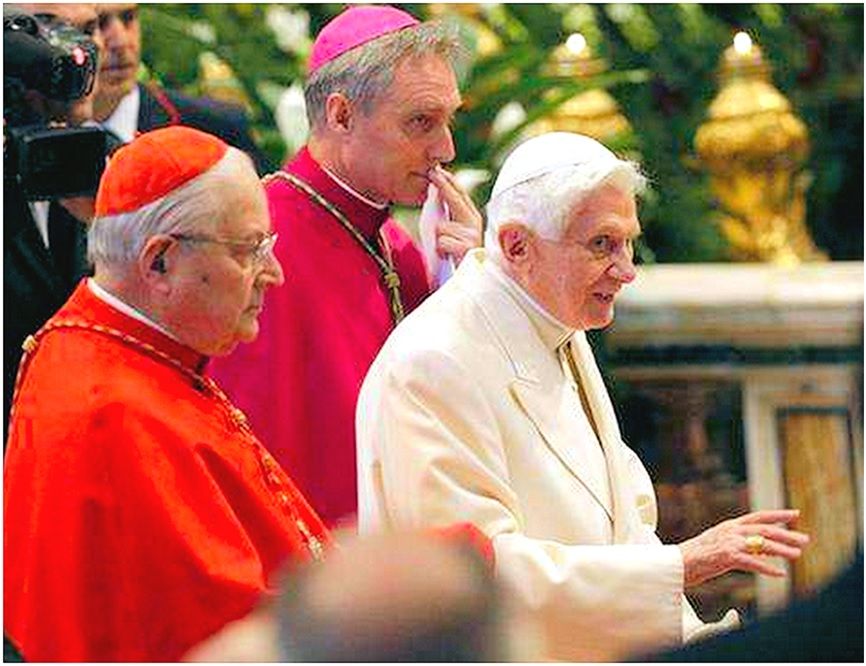
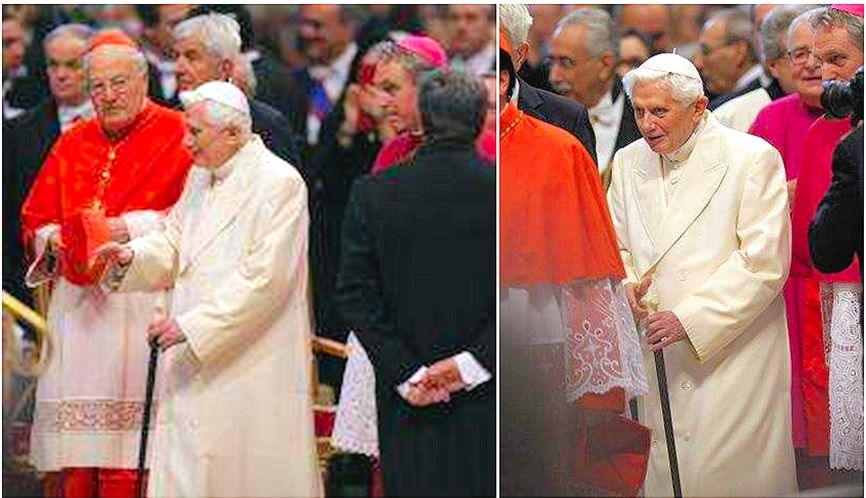
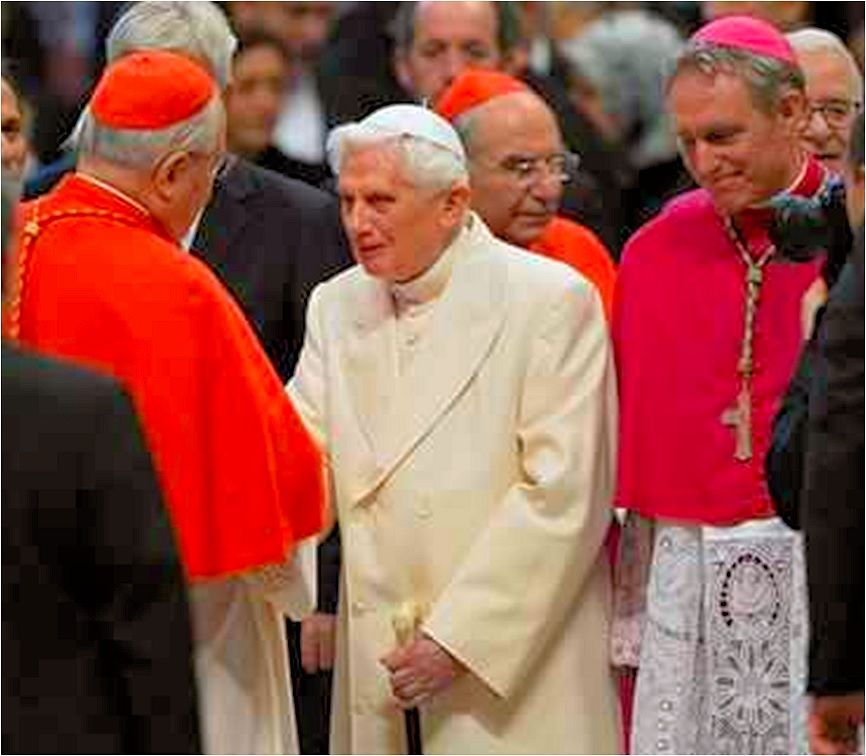
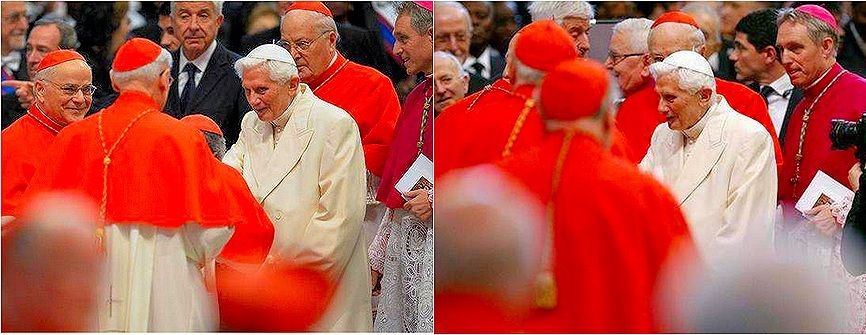
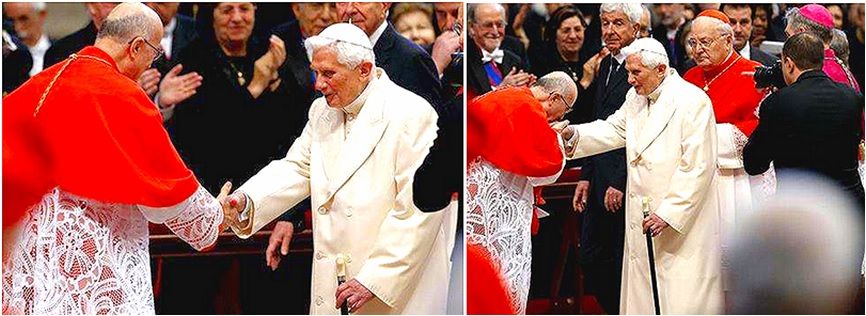
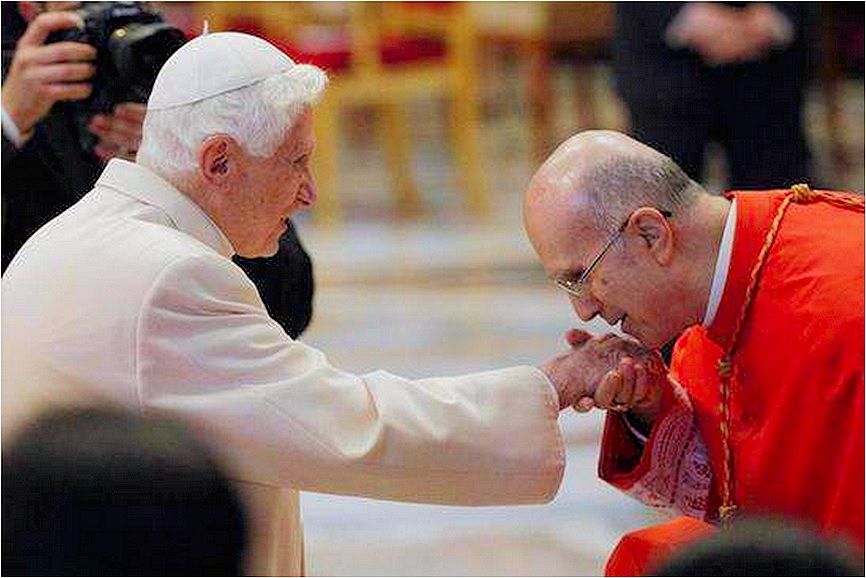

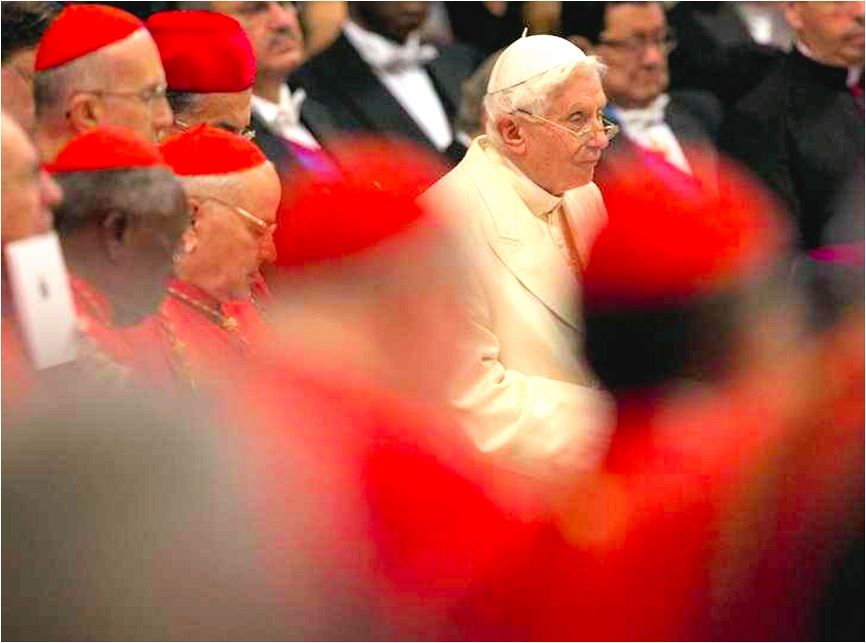
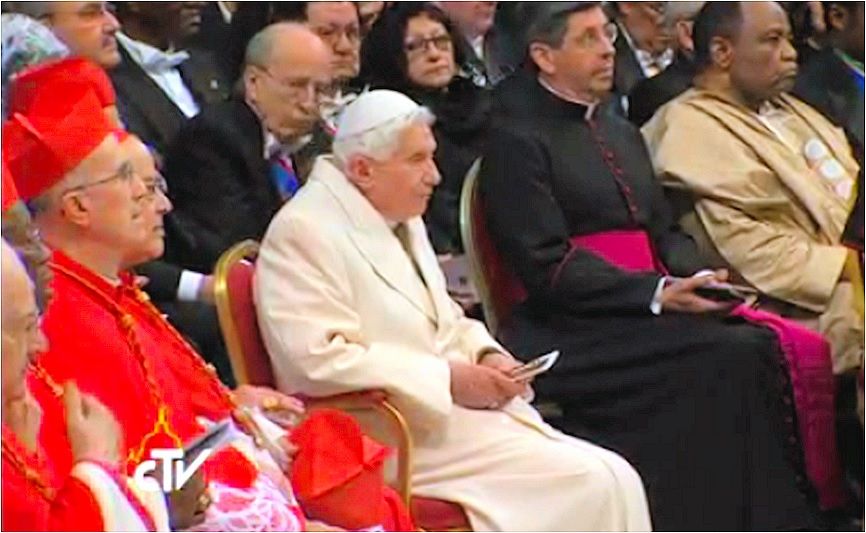
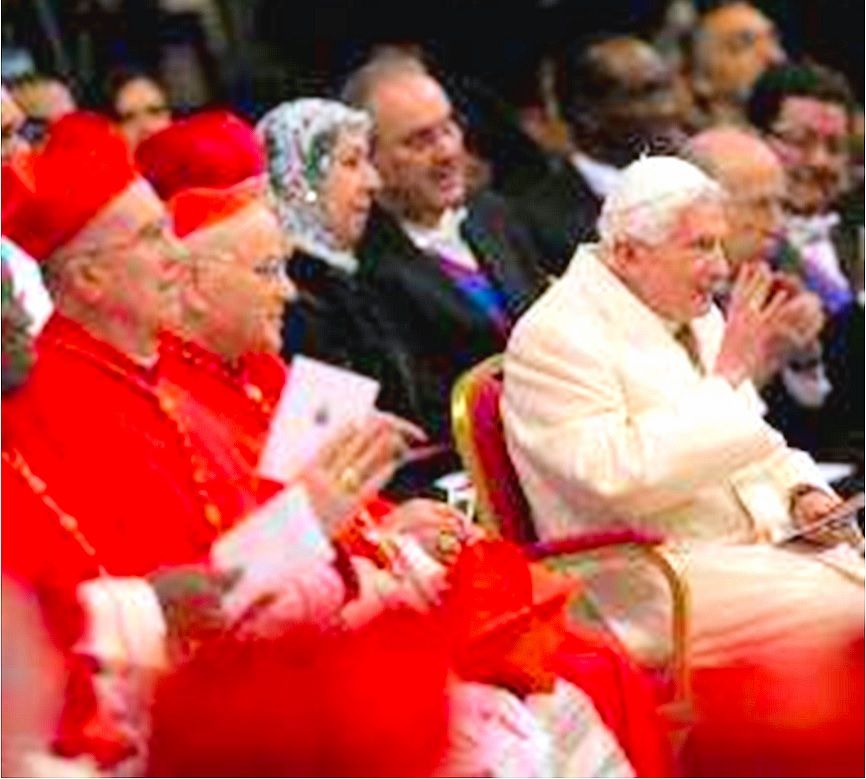
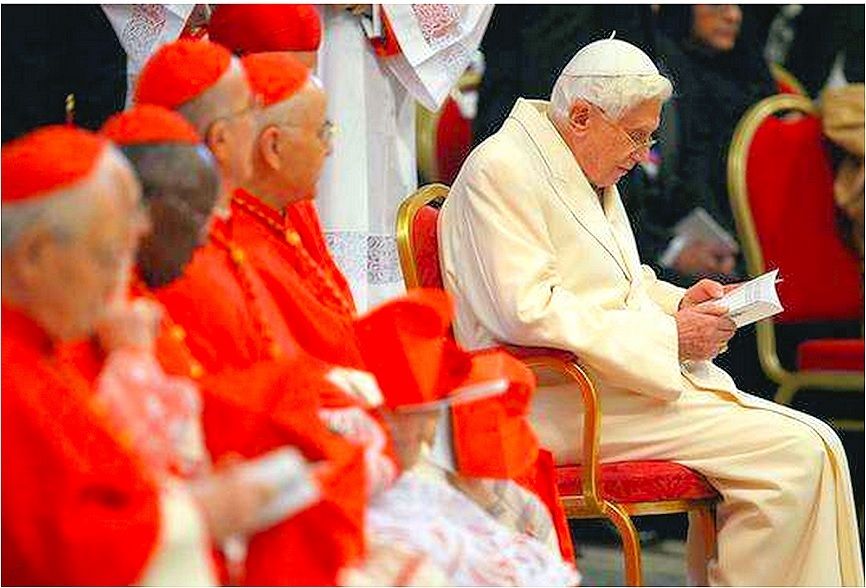 2 Popes on hand in a historic first
2 Popes on hand in a historic first
for a cardinal-making consistory
by Nicole Winfield

VATICAN CITY, February 22, 2014 (AP) — Retired Pope Benedict XVI joined Pope Francis at a ceremony Saturday creating the cardinals who will elect their successor in an unprecedented blending of papacies past, present and future.
Benedict discreetly entered St. Peter's Basilica from a side entrance surrounded by a small entourage and was greeted with applause and tears from the stunned people in the pews. He smiled, waved and seemed genuinely happy to be there, taking his seat in the front row, off to the side, alongside the red-draped cardinals.
It was the first time Benedict and Francis have appeared together at a public liturgical ceremony since Benedict retired a year ago and became the first pope to step down in more than 600 years.
The significance of his presence was multifold, signaling both continuity and even a sign of Benedict's approval of the 19 men Francis had chosen to join the College of Cardinals, the elite group of churchmen whose primary job is to elect a pope.
Francis's choices largely reflected his view that the church must minister to the peripheries and not be a closed institution of rules but rather a place of welcome and mercy. He named cardinals from some of the world's poorest countries, Haiti, Burkina Faso and Ivory Coast among them, tapping many pastors like him. [Yuuuuuk! This kind of mindless and basically malicious commentary still manages to drive me nuts!]
In a sign that Benedict still commands the honor and respect owed a pope, each of the 19 new cardinals — after receiving his red hat from Francis at the altar — went directly to Benedict's seat to greet him before then exchanging a sign of peace with the other cardinals.
[God bless them for doing so, and because of the occasion, I will refrain from my usual jeremiad against the cardinal electors of 2013. Even if some of the new cardinals may have had the same treacherous anti-Benedict mindset at the time.]
After processing down the central aisle at the start of the service, Francis went directly to Benedict, clasped him by his shoulders and they embraced. Francis greeted him in the same way at the end of the service, and Benedict removed his white skullcap in a sign of respect as Francis approached.
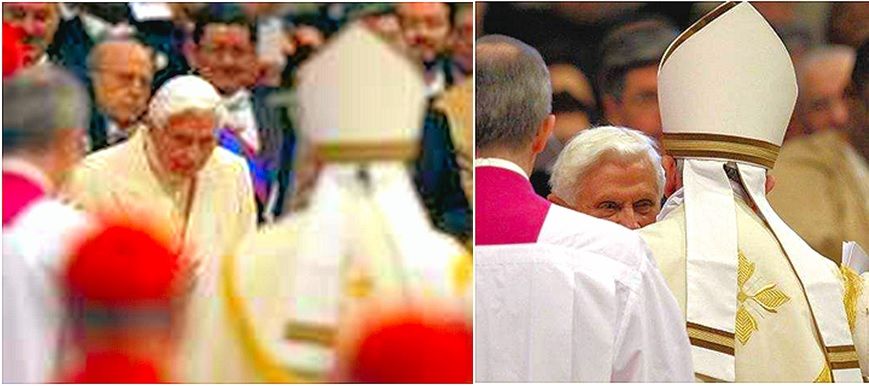
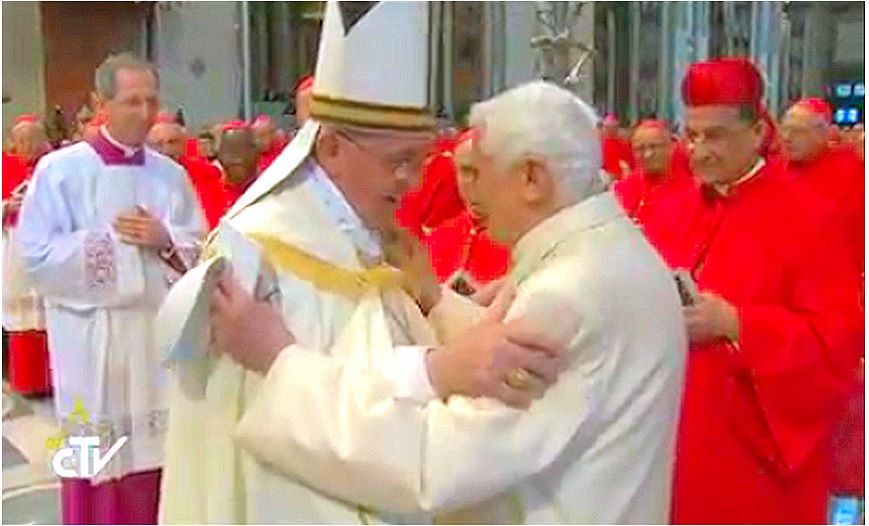
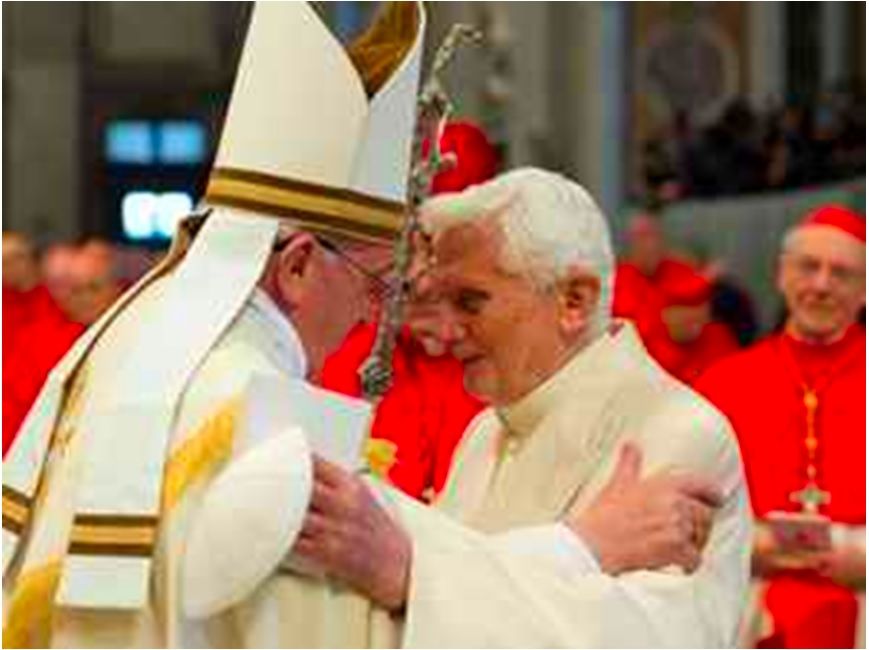
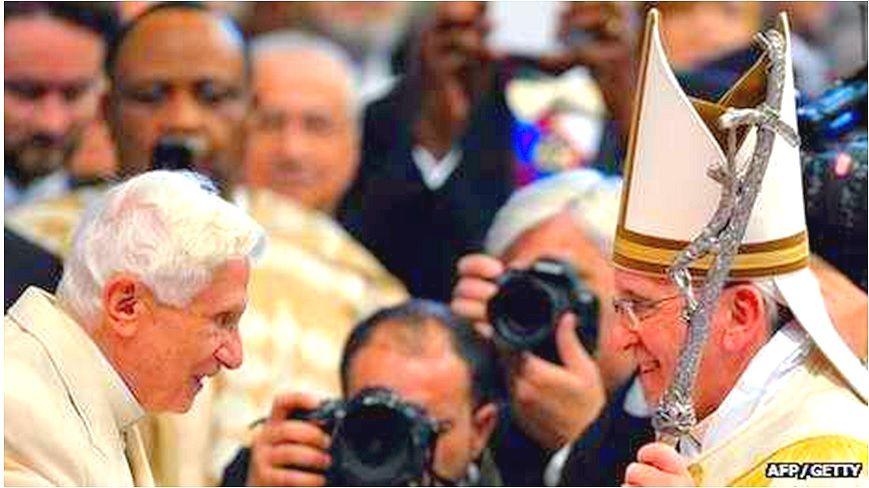
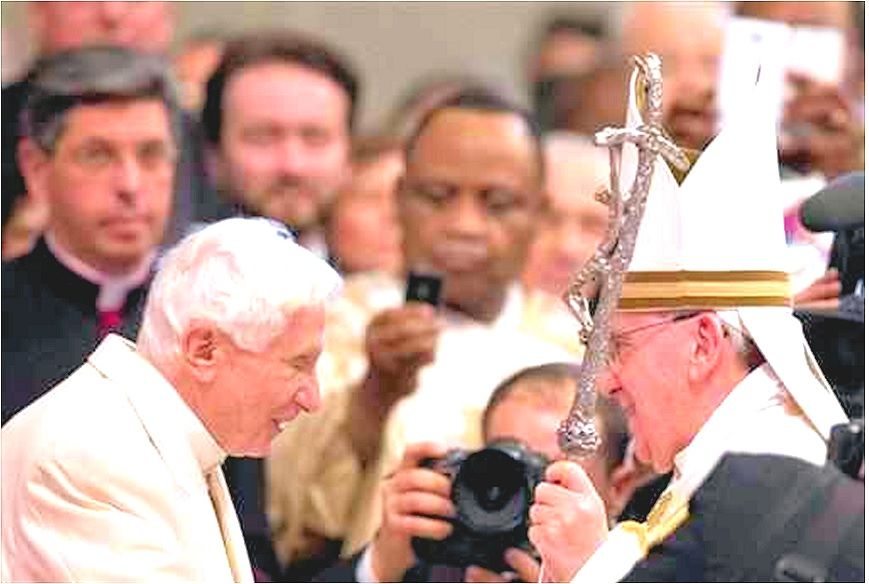
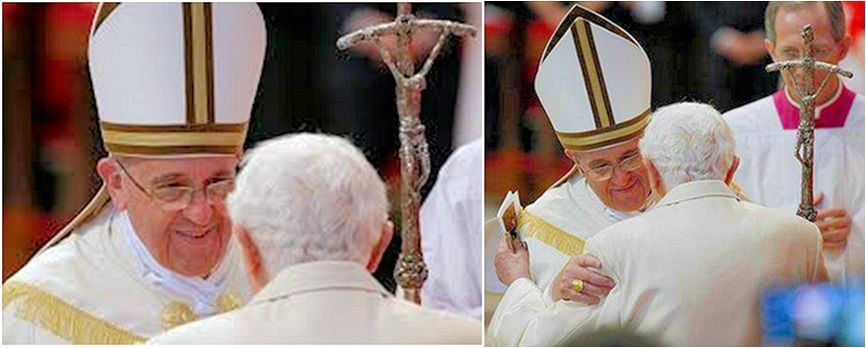

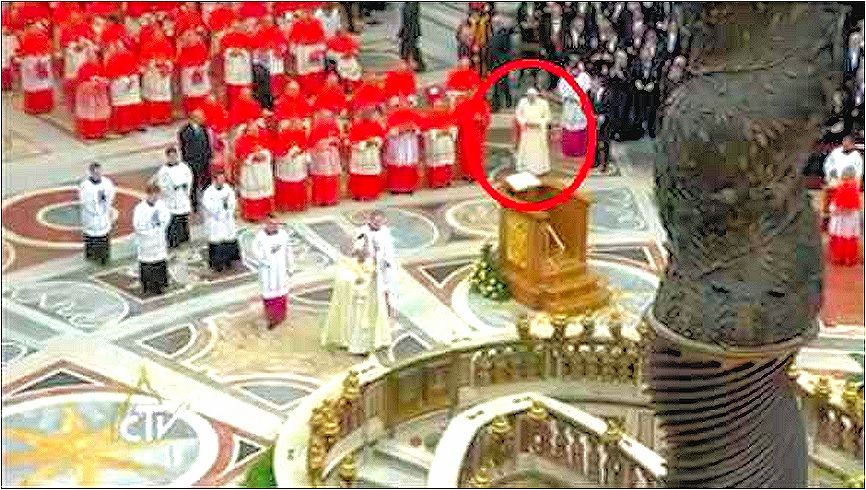
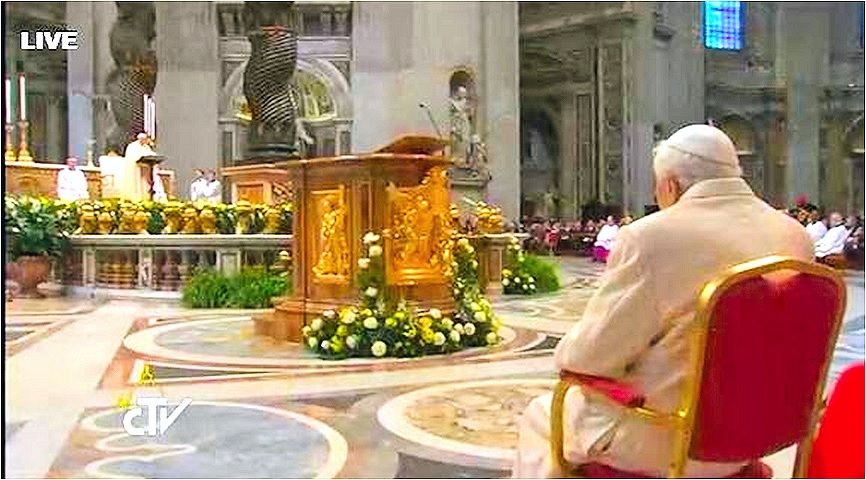
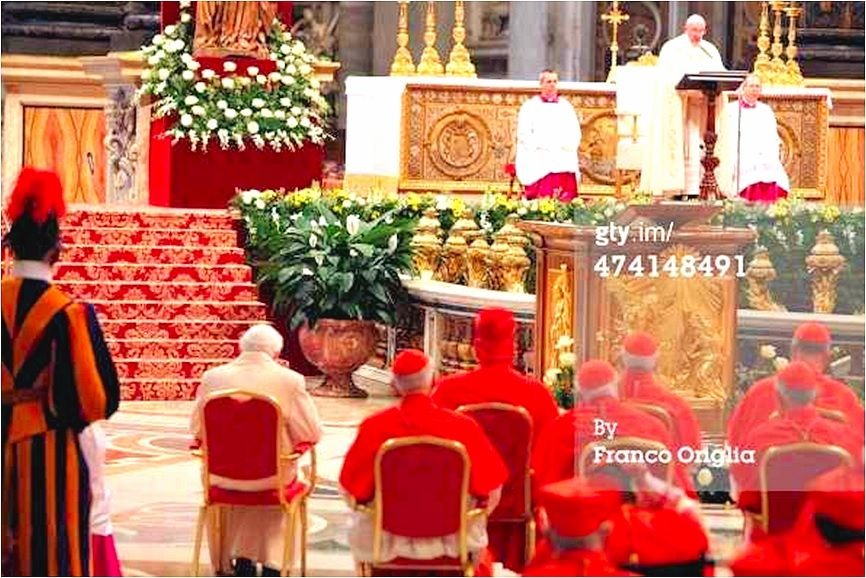
Over the summer, Francis and Benedict appeared together in the Vatican gardens to unveil a statue, but Saturday's event marked one of the most important liturgical ceremonies a pope can preside over: the formal installation of new cardinals.
Saturday's ceremony was thus the latest step in the evolving reality of having two popes living side-by-side inside the Vatican: Benedict's presence marked the a new phase of reintegrating him back into the public life of the church after a period of being hidden away that began almost exactly a year ago with his Feb. 28, 2013 resignation.
With Saturday's precedent, chances grew that Benedict would also appear at the April 27 canonization of his pope, John Paul II, and Pope John XXIII.
[I never had any doubts that Benedict XVI would attend the canonization cven if unknown to everyone else - even if Mons. Gaenswein has to get the Memores to slip him in somehow in a black cassock. somewhere near enough so he can see the altar. In fact, one of the idle conjectures that went through my mind last year when considering the timing of his renunciation was that he must have felt truly unable to go on serving as Pope the way a Pope ought to serve if he could not postpone it long enough till after he could canonize his friend.]
The crowd
erupted in polite applause when one of the new cardinals, Secretary of State Pietro Parolin, greeted Benedict in his introductory remarks at the start of the service, saying "We are grateful for your presence here among us."
Benedict, dressed in his white cassock with a long double-breasted overcoat, again smiled and waved.
[How exactly does a crowd 'erupt in polite applause'? If the applause is only 'polite', i.e., pro forma, surely one cannot use the verb 'erupt'. And why not simply say "the crowd broke into applause' without characterizing the applause at all? Or is it Winfield's idea to diminish any impression that, God forbid the faithful should even acknowledge the 'ex-Pope' in the presence of the Pope gloriously reigning, as the expression has it? Actually, she does not ,judging by her next paragraph below. Now, Cardinal Parolin's statement - yes, that one I would consider as made out of obligatory politeness, truly pro forma, for appearances' sake. Doesn't it just express all the warmth, graciousness and sincerity` of the retirement telegram sent by the cardinals to Benedict XVI last March?]
Some people reached out to try to touch Benedict as he passed by, others tried to approach him to take his photo, but were restrained by ushers.
The occasion for this historic first was Francis's first cardinal-making ceremony to formally welcome 19 new "princes of the church" into the College of Cardinals.....
 Pope Francis bids farewell to Benedict XVI before the recessional at the end of the rites.
[The AP story runs for a few more paragraphs more, and I am sorry for the new cardinals that the media focused on Benedict's unexpected presence in their accounts of the event, but then the news reports also gave short shrift to the Pope's allocution to the new cardinals.
Pope Francis bids farewell to Benedict XVI before the recessional at the end of the rites.
[The AP story runs for a few more paragraphs more, and I am sorry for the new cardinals that the media focused on Benedict's unexpected presence in their accounts of the event, but then the news reports also gave short shrift to the Pope's allocution to the new cardinals.
I have not sorted out all my feelings about today, but I thank God for a blessed day in the life of the Church. Personally, I think Benedict XVI wished to honor the Petrine ministry today on the Feast of Peter's Chair, as someone who has occupied it... And I am thankful once again to Pope Francis for making the invitation that made this possible. God bless the Popes!


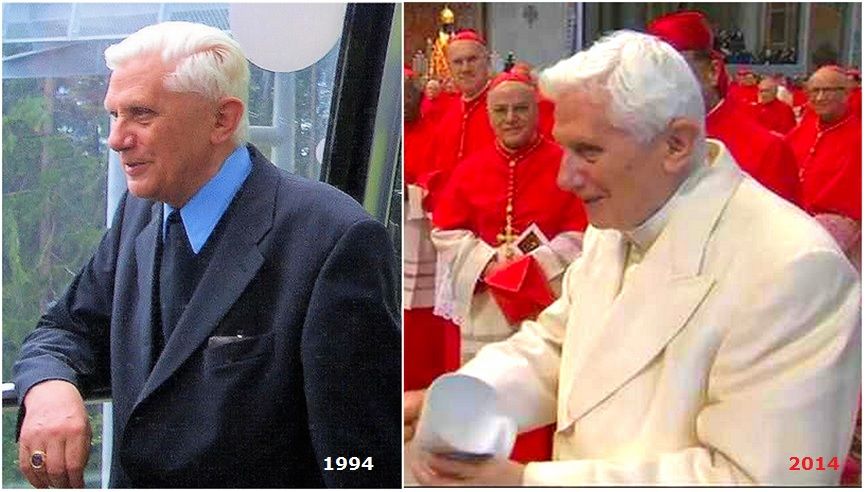
Forgive my self-indulgence, but that last photo of Benedict XVI with Pope Francis made my mind flash back right away to one of my favorite photographs of Cardinal Ratzinger in a suit. It was taken in 1994 at a facility of the Knights of Malta located in the Tyrolean Alps, when he and his brother were on a vacation. Those features are ageless - still the most beautiful man in the world as we used to rave at the time he became Pope when most of us 'discovered' him (and in a reverse process, were not oblivious of his physical beauty and saw it as most fitting and complementary to the spiritual beauty that he so obviously radiates).
Looking back another year beyond...
To the last Solemnity of Peter's Chair that he would observe as Pope, Benedict XVI was on the sixth day of a weeklong Lenten retreat with officials of the Roman Curia. It would end at noon the following day, after a final morning meditation and the Holy Father's traditional closing remarks. All in all, there were 22 meditation sessions, each lecture preached by Cardinal Gianfranco Ravasi, president of the Pontifical Council for Culture.
Benedict, dressed in his white cassock with a long double-breasted overcoat, again smiled and waved.
[How exactly does a crowd 'erupt in polite applause'? If the applause is only 'polite', i.e., pro forma, surely one cannot use the verb 'erupt'. And why not simply say "the crowd broke into applause' without characterizing the applause at all? Or is it Winfield's idea to diminish any impression that, God forbid the faithful should even acknowledge the 'ex-Pope' in the presence of the Pope gloriously reigning, as the expression has it? Actually, she does not ,judging by her next paragraph below. Now, Cardinal Parolin's statement - yes, that one I would consider as made out of obligatory politeness, truly pro forma, for appearances' sake. Doesn't it just express all the warmth, graciousness and sincerity` of the retirement telegram sent by the cardinals to Benedict XVI last March?]
Some people reached out to try to touch Benedict as he passed by, others tried to approach him to take his photo, but were restrained by ushers.
The occasion for this historic first was Francis's first cardinal-making ceremony to formally welcome 19 new "princes of the church" into the College of Cardinals.....
 Pope Francis bids farewell to Benedict XVI before the recessional at the end of the rites.
[The AP story runs for a few more paragraphs more, and I am sorry for the new cardinals that the media focused on Benedict's unexpected presence in their accounts of the event, but then the news reports also gave short shrift to the Pope's allocution to the new cardinals.
Pope Francis bids farewell to Benedict XVI before the recessional at the end of the rites.
[The AP story runs for a few more paragraphs more, and I am sorry for the new cardinals that the media focused on Benedict's unexpected presence in their accounts of the event, but then the news reports also gave short shrift to the Pope's allocution to the new cardinals.
I have not sorted out all my feelings about today, but I thank God for a blessed day in the life of the Church. Personally, I think Benedict XVI wished to honor the Petrine ministry today on the Feast of Peter's Chair, as someone who has occupied it... And I am thankful once again to Pope Francis for making the invitation that made this possible. God bless the Popes!



Forgive my self-indulgence, but that last photo of Benedict XVI with Pope Francis made my mind flash back right away to one of my favorite photographs of Cardinal Ratzinger in a suit. It was taken in 1994 at a facility of the Knights of Malta located in the Tyrolean Alps, when he and his brother were on a vacation. Those features are ageless - still the most beautiful man in the world as we used to rave at the time he became Pope when most of us 'discovered' him (and in a reverse process, were not oblivious of his physical beauty and saw it as most fitting and complementary to the spiritual beauty that he so obviously radiates).

Looking back to Benedict XVI's last observance as Pope of the Feastof Peter's Chair, and a homily that explains the significance of the feast and what it means for the Petrine ministry... It was in 2012. Benedict XVI's fourth consistory to create new cardinals took place on the eve of the Solemnity, and he concelebrated the Mass of the Solemnity itself the next day with the new cardinals. He would call a second cardinal-making consistory in November that year, bestowing the red biretta on six more prelates.
 SOLEMNITY OF PETER'S CHAIR
SOLEMNITY OF PETER'S CHAIR
Holy Mass concelebrated
with the new cardinals

February 19, 2012
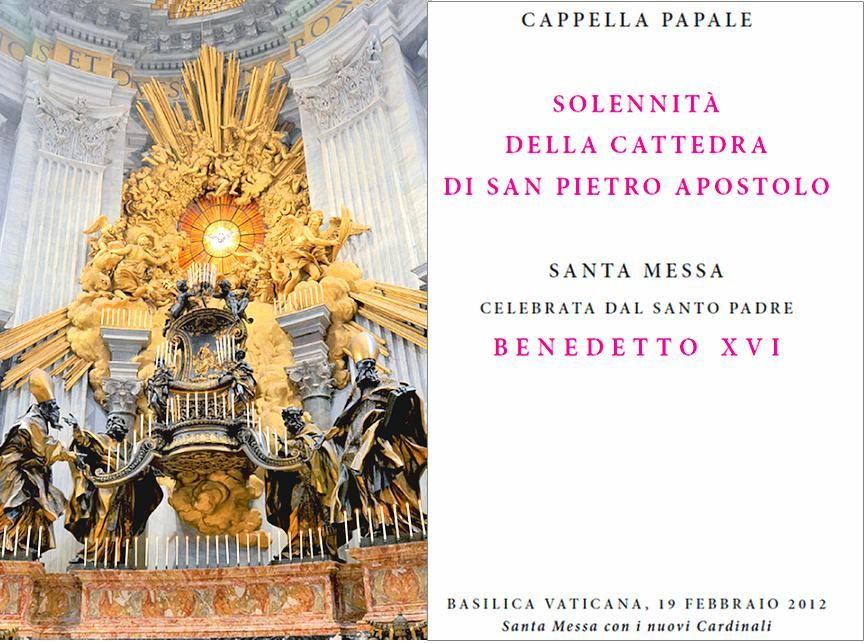 Libretto cover: The Chair of St. Peter, sculpture by Bernini, 1665, enclosing a traditional relic, Altar of the Chair, St. Peter's Basilica.
Libretto cover: The Chair of St. Peter, sculpture by Bernini, 1665, enclosing a traditional relic, Altar of the Chair, St. Peter's Basilica.
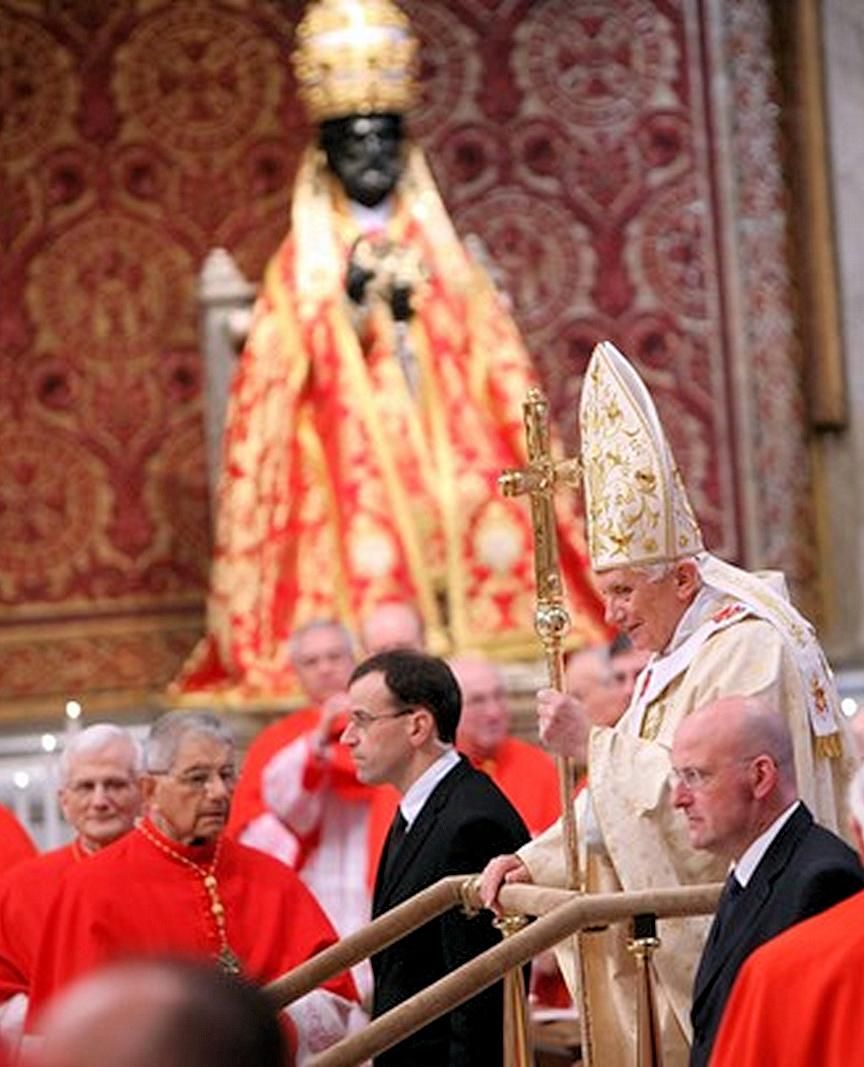 It's a rare occasion when the Pope gets to celebrate the Feast of Peter's Chair in a public Mass!
It's a rare occasion when the Pope gets to celebrate the Feast of Peter's Chair in a public Mass!
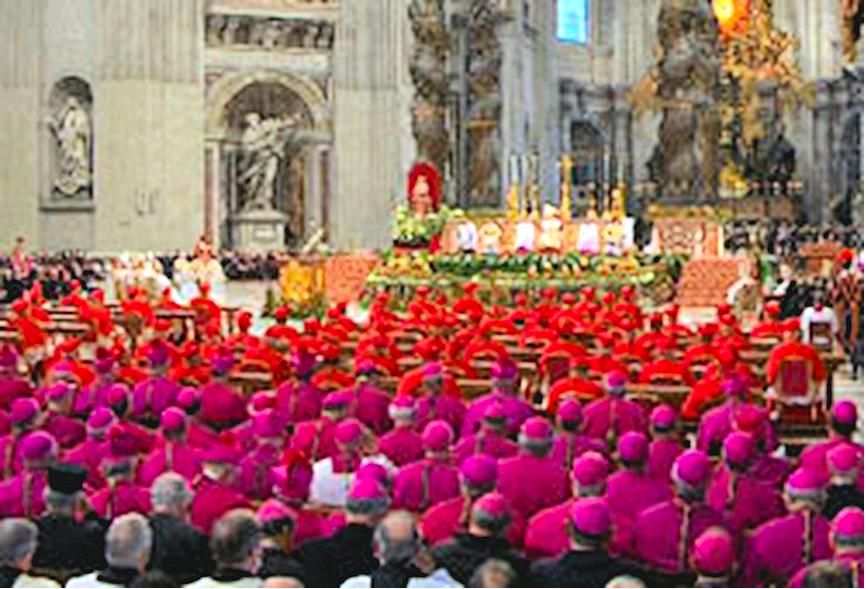
Pope Benedict XVI concelebrated Mass this Sunday morning in St. Peter’s Basilica, on the SoLemnity of Peter's Chair, with the twenty-two Cardinals he created yesterday in the fourth cardinals' consistory of his Pontificate.
In his homily, the Holy Father stressed the centrality of the Petrine ministry – the Pope's special office of care and responsibility for the whole Church everywhere in the world as the Successor to St. Peter. Focusing on the Feast of the Chair of St. Peter, which was moved forward to Sunday from its usual calendar place on February 22nd, since this coming February 22nd is Ash Wednesday, the Holy Father described the great chair surmounting the Altar of the Chair in the Basilica, behind the High Altar, Pope Benedict noted that it is supported by the Fathers of the Church – symbolically represented in statues that bear the chair.
“The two Eastern masters, Saint John Chrysostom and Saint Athanasius, together with the Latins, Saint Ambrose and Saint Augustine, represent the whole of the tradition, and hence the richness of expression of the true faith of the one Church,” said Pope Benedict.
“This aspect of the altar teaches us that love rests upon faith. Love collapses if man no longer trusts in God and disobeys him. Everything in the Church rests upon faith: the sacraments, the liturgy, evangelization, charity. Likewise te law and the Church’s authority rest upon faith.”
It was a theme to which the Holy Father returned in his Angelus address to the thousands of faithful gathered in St. Peter’s Square for the occasion.

Here is the Vatican's English translation of the Holy FaTHer's homily today:
Dear Cardinals,
Brother Bishops and Priests,
Dear Brothers and Sisters,
On this solemnity of the Chair of Saint Peter, we have the joy of gathering around the altar of the Lord together with the new Cardinals whom yesterday I incorporated into the College of Cardinals.
It is to them, first of all, that I offer my cordial greetings and I thank Cardinal Fernando Filoni for the gracious words he has addressed to me in the name of all.
I extend my greetings to the other Cardinals and all the Bishops present, as well as to the distinguished authorities, ambassadors, priests, religious and all the faithful who have come from different parts of the world for this happy occasion, which is marked by a particular character of universality.
In the second reading that we have just heard, Saint Peter exhorts the “elders” of the Church to be zealous pastors, attentive to the flock of Christ (cf. 1 Pet 5:1-2).
These words are addressed in the first instance to you, my dear venerable brothers, who have already shown great merit among the people of God through your wise and generous pastoral ministry in demanding dioceses, or through presiding over the Dicasteries of the Roman Curia, or in your service to the Church through study and teaching.
The new dignity that has been conferred upon you is intended to show appreciation for the faithful labour you have carried out in the Lord’s vineyard, to honour the communities and nations from which you come and which you represent so worthily in the Church, to invest you with new and more important ecclesial responsibilities and finally to ask of you an additional readiness to be of service to Christ and to the entire Christian community.
This readiness to serve the Gospel is firmly founded upon the certitude of faith. We know that God is faithful to his promises and we await in hope the fulfilment of these words of Saint Peter: “And when the chief shepherd is manifested you will obtain the unfading crown of glory” (1 Pet 5:4).
Today’s Gospel passage presents Peter, under divine inspiration, expressing his own firm faith in Jesus as the Son of God and the promised Messiah. In response to this transparent profession of faith, which Peter makes in the name of the other Apostles as well, Christ reveals to him the mission he intends to entrust to him, namely that of being the “rock”, the visible foundation on which the entire spiritual edifice of the Church is built (cf. Mt 16,16-19).
This new name of “rock” is not a reference to Peter’s personal character, but can be understood only on the basis of a deeper aspect, a mystery: through the office that Jesus confers upon him, Simon Peter will become something that, in terms of “flesh and blood”, he is not.
The exegete Joachim Jeremias has shown that in the background, the symbolic language of “holy rock” is present. In this regard, it is helpful to consider a rabbinic text which states: “The Lord said, ‘How can I create the world, when these godless men will rise up in revolt against me?’ But when God saw that Abraham was to be born, he said, ‘Look, I have found a rock on which I can build and establish the world.’ Therefore he called Abraham a rock.”
The prophet Isaiah makes reference to this when he calls upon the people to “look to the rock from which you were hewn ... look to Abraham your father” (51:1-2).
On account of his faith, Abraham, the father of believers, is seen as the rock that supports creation. Simon, the first to profess faith in Jesus as the Christ and the first witness of the resurrection, now, on the basis of his renewed faith, becomes the rock that is to prevail against the destructive forces of evil.
Dear brothers and sisters, this Gospel episode that has been proclaimed to us finds a further and more eloquent explanation in one of the most famous artistic treasures of this Vatican Basilica: the altar of the Chair.
After passing through the magnificent central nave, and continuing past the transepts, the pilgrim arrives in the apse and sees before him an enormous bronze throne that seems to hover in mid air, but in reality is supported by the four statues of great Fathers of the Church from East and West. And above the throne, surrounded by triumphant angels suspended in the air, the glory of the Holy Spirit shines through the oval window.
What does this sculptural composition say to us, this product of Bernini’s genius? It represents a vision of the essence of the Church and the place within the Church of the Petrine Magisterium.
The window of the apse opens the Church towards the outside, towards the whole of creation, while the image of the Holy Spirit in the form of a dove shows God as the source of light.
But there is also another aspect to point out: the Church herself is like a window, the place where God draws near to us, where he comes towards our world. The Church does not exist for her own sake, she is not the point of arrival, but she has to point upwards, beyond herself, to the realms above.
The Church is truly herself to the extent that she allows the Other, with a capital “O”, to shine through her – the One from whom she comes and to whom she leads. The Church is the place where God “reaches” us and where we “set off” towards him: she has the task of opening up, beyond itself, a world which tends to become enclosed within itself, the task of bringing to the world the light that comes from above, without which it would be uninhabitable.
The great bronze throne encloses a wooden chair from the ninth century, which was long thought to be Saint Peter’s own chair and was placed above this monumental altar because of its great symbolic value. It expresses the permanent presence of the Apostle in the Magisterium of his successors.
Saint Peter’s chair, we could say, is the throne of truth which takes its origin from Christ’s commission after the confession at Caesarea Philippi. The magisterial chair also reminds us of the words spoken to Peter by the Lord during the Last Supper: “I have prayed for you that your faith may not fail; and when you have turned again, strengthen your brethren” (Lk 22:32).
The chair of Peter evokes another memory: the famous expression from Saint Ignatius of Antioch’s letter to the Romans, where he says of the Church of Rome that she “presides in charity” (Salutation, PG 5, 801).
In truth, presiding in faith is inseparably linked to presiding in love. Faith without love would no longer be an authentic Christian faith. But the words of Saint Ignatius have another much more concrete implication: the word “charity”, in fact, was also used by the early Church to indicate the Eucharist.
The Eucharist is the Sacramentum caritatis Christi - the sacrament of Christ's love - through which Christ continues to draw us all to himself, as he did when raised up on the Cross (cf. Jn 12:32).
Therefore, to “preside in charity” is to draw men and women into a eucharistic embrace – the embrace of Christ – which surpasses every barrier and every division, creating communion from all manner of differences.
The Petrine ministry is therefore a primacy of love in the eucharistic sense, that is to say solicitude for the universal communion of the Church in Christ. And the Eucharist is the shape and the measure of this communion, a guarantee that it will remain faithful to the criterion of the tradition of the faith.
The great Chair is supported by the Fathers of the Church. The two Eastern masters, Saint John Chrysostom and Saint Athanasius, together with the Latins, Saint Ambrose and Saint Augustine, represent the whole of the tradition, and hence the richness of expression of the true faith of the one Church.
-
This aspect of the altar teaches us that love rests upon faith. Love collapses if man no longer trusts in God and disobeys him. Everything in the Church rests upon faith: the sacraments, the liturgy, evangelization, charity. Likewise the law and the Church’s authority rest upon faith.
The Church is not self-regulating, she does not determine her own structure but receives it from the word of God, to which she listens in faith as she seeks to understand it and to live it.
Within the ecclesial community, the Fathers of the Church fulfil the function of guaranteeing fidelity to sacred Scripture. They ensure that the Church receives reliable and solid exegesis, capable of forming with the Chair of Peter a stable and consistent whole.
The sacred Scriptures, authoritatively interpreted by the Magisterium in the light of the Fathers, shed light upon the Church’s journey through time, providing her with a stable foundation amid the vicissitudes of history.
After considering the various elements of the altar of the Chair, let us take a look at it in its entirety. We see that it is characterized by a twofold movement: ascending and descending. This is the reciprocity between faith and love.
The Chair is placed in a prominent position in this place, because this is where Saint Peter’s tomb is located, but this too tends towards the love of God. Indeed, faith is oriented towards love. A selfish faith would be an unreal faith.
Whoever believes in Jesus Christ and enters into the dynamic of love that finds its source in the Eucharist, discovers true joy and becomes capable in turn of living according to the logic of gift.
True faith is illumined by love and leads towards love, leads on high, just as the altar of the Chair points upwards towards the luminous window, the glory of the Holy Spirit, which constitutes the true focus for the pilgrim’s gaze as he crosses the threshold of the Vatican Basilica.
That window is given great prominence by the triumphant angels and the great golden rays, with a sense of overflowing fulness that expresses the richness of communion with God. God is not isolation, but glorious and joyful love, spreading outwards and radiant with light.
Dear brothers and sisters, the gift of this love has been entrusted to us, to every Christian. It is a gift to be passed on to others, through the witness of our lives. This is your task in particular,
dear brother Cardinals: to bear witness to the joy of Christ’s love. We now entrust your ecclesial service to the Virgin Mary, who was present among the apostolic community as they gathered in prayer, waiting for the Holy Spirit (cf. Acts 1:14).
And here was Benedict XVI's catechesis at the General
audience on the first Feast of Peter's Chair of his Pontificate, on February 22, 2006:
Dear Brothers and Sisters!
The Latin liturgy celebrates today the feast of the Chair of Peter. It is a very ancient tradition, witnessed in Rome since the end of the fourth century, which renders thanksgiving to God for the mission entrusted to the Apostle Peter and his successors.
"Cathedra" literally means the established seat of the bishop, located in the mother church of a diocese, which for this reason is called "cathedral," and it is the symbol of the authority of the bishop and, in particular, of his "magisterium," that is, of the evangelical teaching that he, insofar as a successor of the apostles, is called to guard and transmit to the Christian community.
When the bishop takes possession of the local Church that is entrusted to him, he, bearing the miter and the shepherd's crosier, sits on the cathedra. From that seat he will guide, as teacher and shepherd, the journey of the faithful in faith, hope and charity.
Which was, then, the "cathedra" if St. Peter? He, chosen by Christ as the "rock" on which to build the Church (cf. Matthew 16:18), began his ministry in Jerusalem, after the ascension of the Lord and Pentecost. The first "seat" of the Church was the Cenacle, and in all probability in that room, where Mary, the Mother of Jesus, also prayed with the disciples, a special place was reserved for Simon Peter.
Subsequently, the see of Peter was Antioch, a city situated on the Oronte River in Syria, today Turkey, which at the time was the third metropolis of the Roman Empire after Rome and Alexandria in Egypt. Of that city, evangelized by Barnabas and Paul, where "for the first time the disciples were called Christians" (Acts 11:26), Peter was the first Bishop.
In fact, the Roman Martyrology, before the reform of the calendar [part of the 1969-70 liturgical overhaul], also established also a specific celebration of the Chair of Peter at Antioch. From there, Providence led Peter to Rome, where he concluded with martyrdom his course of service to the Gospel.
For this reason, the See of Rome, which had received the greatest honor, received also the task entrusted by Christ to Peter of being at the service of all the local Churches for the building and unity of the whole People of God.
In this way the See of Rome came to be known as that of the Successor of Peter, and the "cathedra" of its Bishop represented that of the apostle charged by Christ to feed all his flock. It is attested by the most ancient Fathers of the Church, as for example St. Irenaeus, bishop of Lyon, who in his treatise "Against Heresies" describes the Church of Rome as "greatest and most ancient, known by all … founded and constituted at Rome by the two glorious Apostles Peter and Paul"; and he adds: "With this Church, because of her outstanding superiority, the universal Church must be in agreement, that is, the faithful everywhere" (III, 3, 2-3).
Tertullian, for his part, affirms: "How blessed this Church of Rome is! The Apostles themselves shed on her, with their blood, the whole of the doctrine" ("La Prescrizione degli Eretici," 36). The Chair of the Bishop of Rome represents, therefore, not only his service to the Roman community, but also his mission of guide of the whole People of God.
To celebrate the "Chair" of Peter, as we do today, means, therefore, to attribute to it a strong spiritual significance and to recognize in it a privileged sign of the love of God, good and eternal Shepherd, who wants to gather the whole of his Church and guide her along the way of salvation.
Among so many testimonies of the Fathers, I would like to refer to that of St. Jerome, taken from a letter of his to the Bishop of Rome, particularly interesting because he makes explicit reference in fact to the "chair" of Peter, presenting it as the safe harbor of truth and peace.
Jerome writes thus: "I decided to consult the chair of Peter, where that faith is found exalted by the lips of an Apostle; I now come to ask for nourishment for my soul there, where once you received the garment of Christ. I follow no leader save Christ, so I enter into communion with your beatitude, that is, with the chair of Peter for this I know is the rock upon which the Church is built! ("Le Lettere," I, 15,1-2).
Dear Brothers and Sisters, in the apse of St. Peter's Basilica, as you know, is found the monument to the Chair of the Apostle, a mature work of Bernini, made in the shape of a great bronze throne, supported by the statues of four Doctors of the Church, two from the West, St. Augustine and St. Ambrose, and two from the East, St. John Chrysostom and St. Athanasius.
I invite you to pause before that evocative work, which today it is possible to admire decorated with so many candles, and pray in a particular way for the ministry that God has entrusted to me.
Raising one's gaze to the alabaster glass window that opens precisely above the chair, invoke the Holy Spirit, so that he will always sustain with his light and strength my daily service to the whole Church. For this, as for your devoted attention, I thank you from my heart.
May she, Mother of the Incarnate Word, protect the Church’s path, support the work of the pastors by her intercession and take under her mantle the entire College of Cardinals. Amen!
Here is a Vatican Radio translation of the address given by Cardinal Fernando Filoni, Prefect of the Congregation for the Evangelization of Peoples, on behalf of the 22 newly created Cardinals, before today's Mass began:
The scarlet bestowed on us reminds us, Holy Father, not about the greatness of the wearer nor as a symbol of power and domination, but of the profound mystery of the suffering of Jesus: Covered by his captors with a scarlet cloak, and thus presented to the crowd before Pilate, he humbled himself and became obedient unto death, even death on a cross (Phil. 2.8).
Even today in the Church, for their loyalty to his Lord, many of its members face martyrdom, trial and persecution.
Most Holy Father, at this most meaningful moment in our life’s journey, we would like, together with our feelings of gratitude, affection and dedication, to present you as a gift, our renewed commitment of fidelity, our complete willingness in the performance of the specific tasks entrusted to us in the Roman Curia, in the particular Churches or in the service of truth and knowledge. We too wish to wear our robes usque ad effusionem sanguinis - to the point of shedding our own blood.
Our gratitude today is joined by that, no less profound and joyful, of our relatives and friends, the churches where we come from, and the peoples to which we belong.
Every vocation, in fact, is born in a human context and is practiced in the context in which our people live, with whom we build pastoral relationships that can never be erased.
They too, Holy Father, thank you and ensure their prayer for Your person (Conservet eum Dominus - Keep him, Lord) and support for Your supreme and universal ecclesial ministry (TC]Tu es Petrus).
We entrust our service as cardinals to the protection of Mary Mother of Grace. Indeed it is Christ himself, who from the Cross places us under his protective mother, "Woman behold your son!" (Jn 19, 26). And we ask you, our Mother, come abide with us.
To God blessed for ever, our prayerwill be raised with the same Marian words: "My soul magnifies the Lord and my spirit rejoices in God my Savior" (Lk 1.46 to 47).


